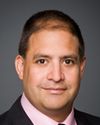From our prior discussions, you're familiar with some of the background information that you see on slide 2. For the purposes of this discussion, it is important to note that we are a large training facility for medical residents and nursing and other allied health professionals throughout the United States. This means that these individuals are exposed not only to the veterans but to our electronic health record.
On slide 3, you see a screen capture of the face sheet of our electronic health record, the basis of which is known as VistA, the veterans health information systems and technology architecture. The computerized patient record system actually sits on top of this system called VistA, which we've had for almost three decades. The interface with the clinician and the electronic health record is about a decade old. This is available throughout the country. If a veteran is seen in New York and goes on vacation in Florida, the clinicians there can access the information, including images from around the country.
On slide 4, we have pictorial representations of the use of the electronic health record in place. In the upper right-hand corner is a cardiologist using the imaging component. Imaging encompasses not only radiology images but also cardiology images and waveforms. It could be a video of an entire procedure, for example.
On slide 5, we go into a little bit of what I referred to earlier as this availability of data no matter where the veteran presents. We have different applications that are used for this. The thing you might be interested in is that the component of VA that does the benefits determination for compensation also has access to our electronic health record. For example, when diabetes related to Agent Orange exposure in Vietnam is determined to be what we call automatically adjudicated if the veteran has diabetes and was exposed to Agent Orange, for those veterans that we treat directly, we can use the electronic health record to actually find that without bringing the veteran back in.
So there are uses for direct clinical care, for quality oversight, and for benefits determinations.
Slide 6 talks a little bit about that evolution I referred to and the fact that for almost three decades our practitioners have been able to look up lab results, radiology results, and pharmacy information in electronic format. Over time, really, what we've built on top of that is the clinicians actually ordering their own medications and seeing their own drug-drug alerts and other clinical decisions support that's presented to them.
Slide 7 shows some comparative statistics of the volume that we're talking about within our electronic health record system. It's just a point of reference. Because of the nature of how we provide care, which is much like a closed system such as yours, it means that we do reap the benefits of providers not reordering a lab test because the results were not available. Or it means referring a patient to a consulting physician and making sure that information is available without repeating radiology tests or laboratory tests just due to the unavailability of records and results. This talks about that economic benefit a little bit.
I want to touch briefly on our sharing with the Department of Defense. We have done this incrementally over time. It began with just the ability to view Department of Defense information. The most recent evolution is actually invoking clinical decision support on information from the Department of Defense in our system and the VA system and, in turn, the Department of Defense invoking clinical decision support. So it means that drug-drug and drug allergy interactions are performed not just on the information within the local database, but actually across the two organizations.
The “Quality Evidence” slide just talks about how our electronic health record has really been noted throughout the country, both in the private sector and in the public sectors, for the impact it has had in the area of economic savings, as I just discussed, but also in the area of quality and that ability to remind physicians of interventions for chronic disease patients or preventative medicine interventions such as influenza vaccinations or pneumococcal vaccinations.
The next slide, slide 11, provides a link to a demonstration site of our electronic health record.
I was also asked to cover the personal health record, which is a newer project for VA. The vision was that patients would be in control of their information, including information they record in this online database, but also that it would serve as a trusted source of health information. We collaborated with the Department of Defense to contract for a commercial health information module, and we actually augmented that with veteran-specific diseases, injuries, and mental health conditions. It has really evolved over time.
I'll talk about that a little bit. It was to improve access to services. It's also the way we provide for the veteran to communicate if they have external-to-VA physicians or want to look for assistance for a family member in the progress of their treatment. So we list some of those benefits here: improved communication and enhanced satisfaction with resources.
For example, in 2008 we added the ability for parts of the medical record to be available online to the veteran through this personal health record portal, so that they wouldn't have to come to the hospital to obtain a copy of their lab results or radiology results. This year, in 2009, we're adding the ability for veterans to communicate with their clinicians through a secure portal on My HealtheVet to ask questions or to clarify treatment requirements.
On slide 16 we've added some of the statistics about this. As we've added new functionality, it has encouraged more veterans to participate. For example, when we added the ability to refill prescriptions online, there was a large surge in the number of veterans who signed up online to participate in My HealtheVet. We anticipate a similar surge will come this year when we add the ability for provider-patient communications.
The next slide talks a little more about that. The veterans can also use this site to record military histories or personal histories, or as a diary to record their blood pressure, temperature, weight, anything that they may be tracking personally or that their provider has asked them to track.
The other things that we use both of these tools for are patient education and patient involvement. It's a big impact to the patient when you can show that a new medication or a change in lifestyle—weight loss or stopping smoking—reflects in their lab results or their spirometry results. To make that correlation between changes in behaviour in a positive or negative way has been another use of the electronic health record and the personal health record.
On My HealtheVet we also collaborate with research to make sure that veterans are aware of research opportunities specific to their disease or specific to veterans. This is another functionality that we use.
We talked earlier about the ability of veterans to refill prescriptions online through My HealtheVet, and we've depicted that here with the My HealtheVet pharmacy options. As I indicated earlier, this was certainly a highly requested feature. All of the features that we've added to the personal health record are determined by veteran focus groups and veteran advisory groups that tell us what they would like to see.
We believe these two tools are complementary. For example, we're doing more monitoring in the patient's home through our telehome health. So if we have a chronic disease patient with congestive heart failure and we want to monitor their vital signs daily and just generally how they're feeling, we transmit all of that information to a nurse, who may be monitoring 200 to 300 patients. She can intervene at any point when seeing any of the indicators going in the wrong direction.
Then they maybe contact someone else, the nurse picking up a phone and calling the veteran. We've found that this has avoided hospitalizations, has reduced lengths of stay, and has had a positive impact. It's possible because of these two technologies that support alternative treatment modalities, bearing on the electronic health record and the personal health record.
We also use this to remind the veteran when preventative services are due, and we find it to be an effective way to do these reminders— for vaccinations, or to remind patients to wear a seat belt or to quit smoking. We are adding reminders to the functionality.
The other thing we're adding to our electronic health record is an indicator to the provider. This way they know that the patient they're dealing with has a personal health record that can be used for communication, to examine results, or to access health information resources available through My HealtheVet.
Let me now turn to future releases. There is secure messaging, which has been highly requested. We had problems doing that via regular e-mail, so we looked in the United States and other places and found providers that were more experienced in using electronic communication with their patients, and we decided on the secure portal approach. We're also adding things like MyRecoveryPlan to use as an education tool between the provider and a patient recovering from surgery or other interventions. In the future, we hope to add components that will enable the patients to request appointments and do some other health care business online. There are some veterans who have co-payments that are due, and those co-payment balances can also be monitored online.
I'm ready to answer your questions.










